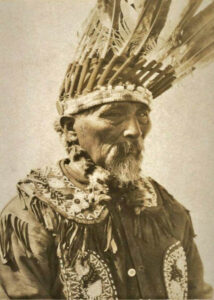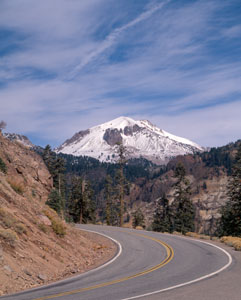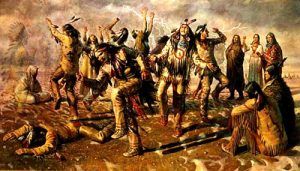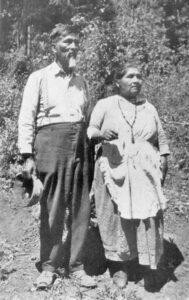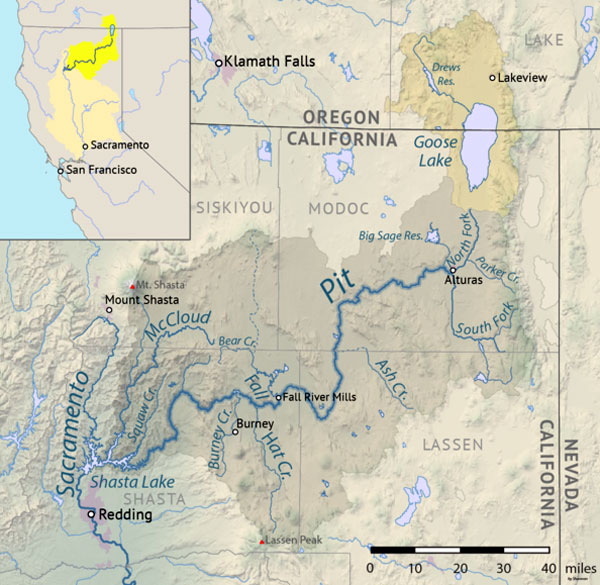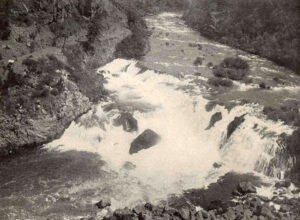The Pit River Indian tribe traditionally occupied lands along the Pit River in the far northeastern part of California, which included Mount Shasta and Lassen Peak to the Warner Range. Twenty peaks over 6,000 feet are scattered over the Pit River interior area, breaking it into many distinct valley and stream systems.
The tribe comprised 11 bands, including the Achomawi, Aporidge, Astariwawi, Atsuge, Atwamsini, Hanhawi, Hewisedawi, Ilmawi, Itsatawi, Kosalextawi, and Madesi, and spoke the languages of Achumawi and Atsugewi, a branch of the greater Hokan linguistic family.
Their name comes from the group’s unique hunting technique, which involved digging pits along the river for deer to fall into. The tribe is made up of descendants of the Achumawi and Atsugewi.
The Achumawi lived along the Pit River in northern California in a collection of individually organized villages that maintained ties with one another. The name Achumawi comes from a word meaning “river.”
There were two Atsugewi groups: the Pine Tree People, who lived in the densely wooded area north of Mount Lassen, and the Juniper Tree People, who lived in the drier plains in and around Dixie Valley, northeast of Lassen Peak. The two groups spoke a shared language. The name Atsugewi comes from atsuke, the Native name for a place along Hat Creek. They were also called Hat Creek Indians.
The Achumawi and the Atsugewi were on good terms and frequently renewed friendship ties through marriage.
Like other northern California Indians, they lived by hunting, gathering, and fishing, with their main foods being fish, acorns, grasshoppers, plants, and small animals. Although they inhabited a fairly small region, they traveled every part of it, looking for food and visiting with neighbors. They rowed swiftly down California rivers in canoes dug out of pine trees. They hunted in high and low mountain regions, plains and valleys, swamps and marshes, grasslands, and meadows.
The Pit River Indians were fairly peaceful and did not like fighting except when provoked. When challenged, they sometimes sent a peacemaker to resolve issues with hostile tribes. The Modoc, Paiute, and Klamath made frequent hostile invasions into their territory and captured and enslaved their women and children.
American fur trappers entered the Pit River region in 1827, and soon the Native population was overcome by a malaria epidemic. In the mid-19th century, they numbered about 3,000.
The tribe lost territory after Mexico gave California to the United States in 1848 and after gold was discovered in 1849. As hundreds of settlers passed through their lands, relations strained, and conflicts erupted throughout the 1850s.
“A band of white men from Red Bluff attacked the Fall River Achomawi in a camp at Beaver Creek and slaughtered the entire number except 30 or 40 men, who escaped. About 160 were killed.” — Edward S. Curtis, in The North American Indian, related an eyewitness account of an encounter in the 1850s.
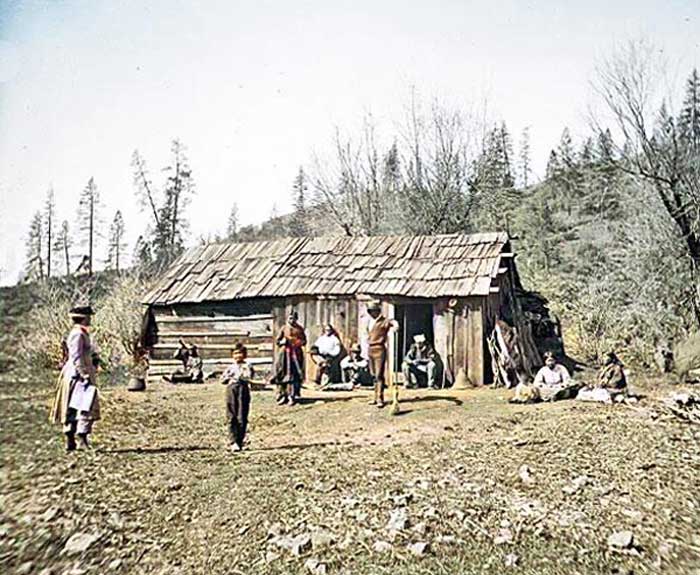
Pit River Indian Home, 1875. Touch of color LOA.
In 1856 Atsugewi warriors attacked whites who had settled on their land. Three years later, an entire friendly Atsugewi group was killed by angry settlers, who mistakenly believed their village was responsible for the murder of some whites in Hat Creek.
Outnumbered and weakened by death and diseases, the Indians were no match for the invading settlers. By 1860 the surviving Atsugewi and Achumawi were removed to Round Valley Reservation in Mendocino County, where members of several other California tribes were already confined.
The government expected reservation Indians to give up their culture and become more like white Americans. It was not long before some Pit River Indians became disenchanted with life on the reservation and made their way back to their homeland.
Some Pit River Indians were drawn to the Ghost Dance Religion of 1890. This was a movement started by a prophet named Wovoka, a member of the Paiute tribe. The Ghost Dance was a circle dance where performers often went into trances and “visited” dead friends and relatives.
The Pit River Indians on the reservation did their best until the General Allotment Act of 1897 (the Dawes Act) was passed. This act divided former Indian lands into small parcels, which were given to individual individuals to farm. Unfortunately, most of these parcels were not suitable for farming. When the Pacific Gas and Electric Company offered to buy these parcels between 1917 and 1930, many Pit River Indians sold their allotments.
Between 1915 and 1938, the U.S. government purchased seven small plots of land for the still-homeless Pit River Indians. These plots were called rancherias, a Spanish term for a small ranch. Like allotments, rancheria land was mostly unsuitable for farming. The largest of the rancherias, the X-L Ranch Reservation, consists of 9,255 acres of cattle-grazing land and is now the home base of the Pit River Tribe.
Beginning in 1919, the Pit River Tribe took part in several lawsuits over land that was taken from them illegally. This would continue for years until a settlement was finally reached in 1963. In the settlement between the U.S. government and all the Native Americans of California, the Indians agreed to share $29 million, which amounted to about $.47 an acre. The Pit River Indians initially rejected the settlement. The U.S. Bureau of Indian Affairs then sent a letter to all members of the tribe asking for their votes, and based on their responses, the Bureau said the tribe accepted the settlement. Some tribal representatives said those who voted yes did not fully understand the issues. The settlement went through, but members of the tribe disagreed bitterly among themselves over the matter.
Some of the most unhappy members of the tribe joined in Native American protest actions during the 1960s. Protestors complained about the unjust taking of their lands and too much government interference in tribal affairs, among other grievances. These protests sparked a movement among Pit River Indians, then scattered throughout northern California. They joined together for a common goal — their recognition by the U.S. government as the Pit River Tribe. Federal recognition was granted in 1976, establishing an official relationship between the tribe and the government.
In the early 21st century, the 11 bands of Pit Indians shared several of their rancherias with other tribes, including the Yana, Maidu, Pomo, Paiute, Wintun, and others.
Over the years, the Pit River Tribe has faced many challenges but has remained resilient and continues to work towards preserving its cultural traditions and promoting the well-being of its community.
The tribe has a rich cultural heritage that includes traditional practices such as basket weaving, beadwork, and the making of regalia for ceremonial dances. The tribe has also maintained a strong connection to the land, and many members continue to engage in subsistence activities such as fishing, hunting, and gathering. They are extremely private people unwilling to reveal details of their history or present way of life.
Today around 1,800 tribal members live on several rancherias and the Pit River, Round Valley, and X-L Ranch reservations. They also own 79 acres in Burney, California, where their tribal headquarters are located. The tribe operates several programs and services to support its members, including health care, education, housing, and social services. The tribe also strongly commits to environmental stewardship and sustainable resource management and works closely with federal and state agencies to protect the natural resources of their ancestral lands.
More Information:
Pit River Tribe
36970 Park Avenue
Burney, CA 96013
© Kathy Alexander/Legends of America, March 2023.
Also See:
Native American Heroes & Leaders
Native American Photo Galleries
Native Americans – The First Owners of America
Sources:
Department of Interior
Encylopedia.com
Pit River Tribe
Wikipedia

